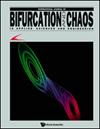Chaotic Model of Muscle and Joint Interactions Based on CPG for Rehabilitation of Incomplete Spinal Cord Injury Patients
IF 2.3
4区 数学
Q2 MATHEMATICS, INTERDISCIPLINARY APPLICATIONS
引用次数: 0
Abstract
The aim of modeling musculoskeletal systems is to understand the mechanisms of locomotion control in terms of neurophysiology and neuroanatomy. The complexity and unique nature of neuromuscular systems, however, make control problems in these systems very challenging due to several characteristics including speed and precision. Thus, their investigation requires the use of simple and analyzable methods. Consequently, taking into account the central pattern generator’s (CPG) function, we attempted to create a structured chaotic model of how human joints and muscles interact for the purpose of facilitating gait and rehabilitation in patients with incomplete spinal cord injury. The four muscle groups used in this model are gluteus, and hip flexor groups for flexion and extension of the hip joints as well as hamstring muscles and vasti muscles for flexion and extension of the knee joint. The results indicate that the output of the chaotic model of muscle and joint interactions in a healthy state would be chaotic, while in the incomplete spinal cord injury state, it would remain a fixed point. For model rehabilitation, afferent nerve stimulation is used in a CPG model; based on the modeling results, by applying coefficients of 1.98, 2.21, and 3.1 to the values of Ia, II, and Ib afferent nerves, the incomplete spinal cord injury model state is changed from a fix-point to periodic in a permanent fashion, suggesting locomotion with rehabilitation in our model. Based on the results obtained from the chaotic model of muscle and joint interactions as well as the comparisons made with reference papers, it can be stated that this model has acceptable output while enjoying simple computations and can predict different norms.基于 CPG 的肌肉与关节相互作用混沌模型用于不完全脊髓损伤患者的康复治疗
建立肌肉骨骼系统模型的目的是从神经生理学和神经解剖学角度理解运动控制机制。然而,神经肌肉系统的复杂性和独特性使得这些系统中的控制问题因其速度和精确度等几个特点而极具挑战性。因此,对它们的研究需要使用简单和可分析的方法。因此,考虑到中央模式发生器(CPG)的功能,我们尝试创建一个人体关节和肌肉相互作用的结构化混沌模型,以促进不完全脊髓损伤患者的步态和康复。该模型中使用的四个肌肉群是臀肌群、髋关节屈肌群(用于髋关节的屈伸)以及腿筋肌群和腓肠肌群(用于膝关节的屈伸)。结果表明,在健康状态下,肌肉和关节相互作用混沌模型的输出将是混沌的,而在不完全脊髓损伤状态下,输出将保持一个固定点。根据建模结果,通过对 Ia、II 和 Ib 传入神经的值应用 1.98、2.21 和 3.1 的系数,不完全脊髓损伤模型状态从定点永久性地转变为周期性,这表明我们的模型中存在康复运动。根据肌肉和关节相互作用混沌模型得出的结果以及与参考文献的比较,可以说该模型具有可接受的输出,同时计算简单,并能预测不同的规范。
本文章由计算机程序翻译,如有差异,请以英文原文为准。
求助全文
约1分钟内获得全文
求助全文
来源期刊
CiteScore
4.10
自引率
13.60%
发文量
237
审稿时长
2-4 weeks
期刊介绍:
The International Journal of Bifurcation and Chaos is widely regarded as a leading journal in the exciting fields of chaos theory and nonlinear science. Represented by an international editorial board comprising top researchers from a wide variety of disciplines, it is setting high standards in scientific and production quality. The journal has been reputedly acclaimed by the scientific community around the world, and has featured many important papers by leading researchers from various areas of applied sciences and engineering.
The discipline of chaos theory has created a universal paradigm, a scientific parlance, and a mathematical tool for grappling with complex dynamical phenomena. In every field of applied sciences (astronomy, atmospheric sciences, biology, chemistry, economics, geophysics, life and medical sciences, physics, social sciences, ecology, etc.) and engineering (aerospace, chemical, electronic, civil, computer, information, mechanical, software, telecommunication, etc.), the local and global manifestations of chaos and bifurcation have burst forth in an unprecedented universality, linking scientists heretofore unfamiliar with one another''s fields, and offering an opportunity to reshape our grasp of reality.

 求助内容:
求助内容: 应助结果提醒方式:
应助结果提醒方式:


